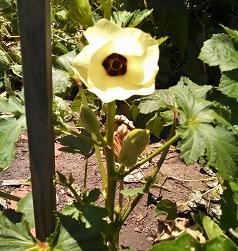How's Your Okra Doing?
Advice From the Help Desk of the
UC Master Gardener Program of Contra Costa County

UC Master Gardener Help Desk: I did some research to determine possible causes for the reduced production of okra in your garden this year as compared to last year. I suspect that the high daytime temperatures that we've experienced on and off throughout the summer have contributed to the reduced production. My research also indicates that temperatures above 90° F (some sources say above 95°F) can interfere with pollination of okra and cause flowers and buds to drop. You reported in your latest message that you have noticed some encouraging signs that more pods may have started forming recently, which could be the result of the cooler temperatures that we had for several successive days last week.
Of course, we also experienced high temperatures from time to time last year when you report that production was much higher. So, there may be some other factors at work. You mentioned that you were doing some supplemental watering for the okra last summer to add to what was provided by your scheduled drip system. My research did indicate that water stress can also reduce pollination rates for okra. So perhaps the reduction in watering this year has also contributed to the reduced production rate.

One other consideration could be the fertility of the soil. Too much nitrogen will encourage lots of green growth but can suppress fruit development. Also, plants need adequate phosphorous which supports blooming and fruit production. If you have a soils test kit, it might be worth checking the fertility levels of the soils in the okra bed. If phosphorous is too low, you could supply a boost with a foliar spray or soil drench of a liquid fertilizer that is high in phosphorous. Just be careful not to supply more nitrogen if the current levels are already adequate.
One other fact I learned from my research is that you can prolong the production period of okra by cutting off about 1/3 of the plant top in late summer. This pruning allows plants to send out new growth and flower and fruit for a second time in the fall.
I hope this information is useful. You are welcome to contact our Help Desk if you have further questions.
Help Desk of the UC Master Gardener Program of Contra Costa County (TKL)
Editor's note: For more information on okra gardening, a Sonoma County MG article is recommended (click)... the pictures in this blog post came from that article.
Note: The UC Master Gardeners Program of Contra Costa's Help Desk is available year-round to answer your gardening questions. Except for a few holidays, we're open every week, Monday through Thursday for walk-ins from 9:00 am to Noon at 75 Santa Barbara Road, 2d Floor, Pleasant Hill, CA 94523. We can also be reached via telephone: (925) 646-6586, email: ccmg@ucanr.edu, or on the web at http://ccmg.ucanr.edu/Ask_Us/ MGCC Blogs can be found at http://ccmg.ucanr.edu/HortCoCo/ You can also subscribe to the Blog (//ucanr.edu/blogs/CCMGBlog/).